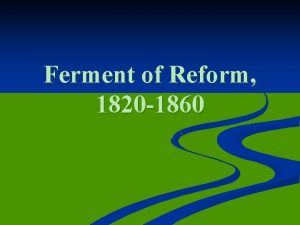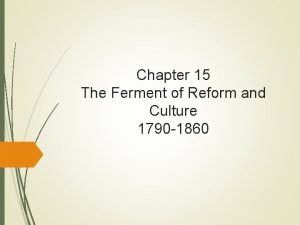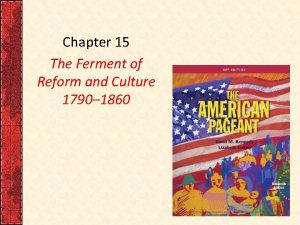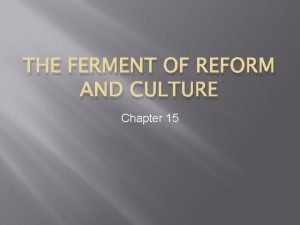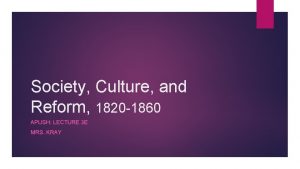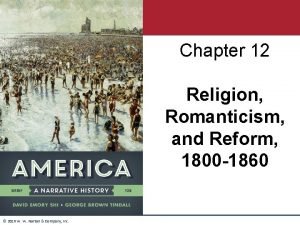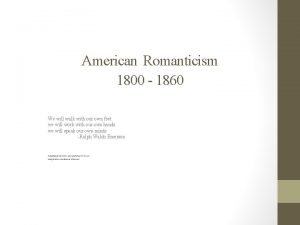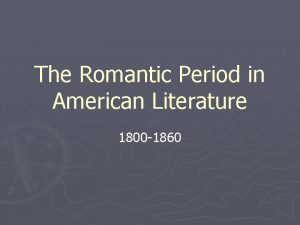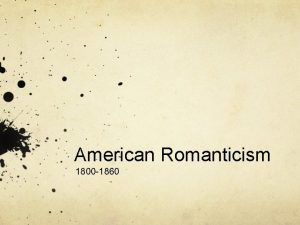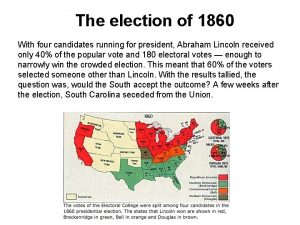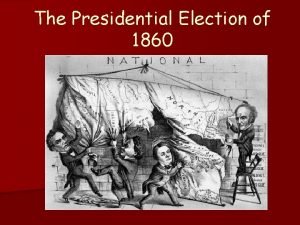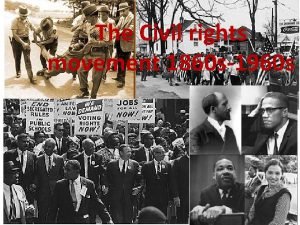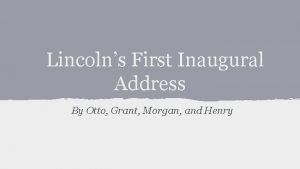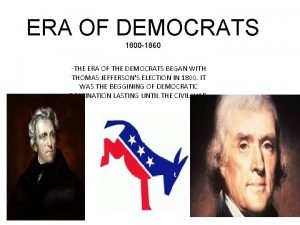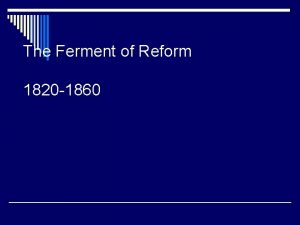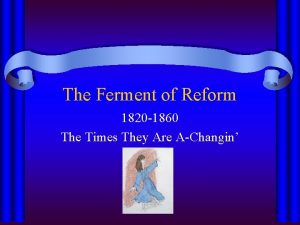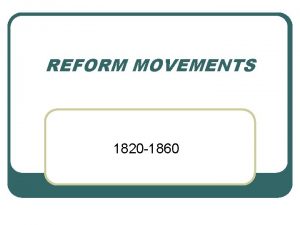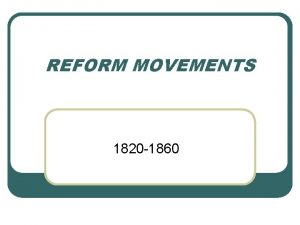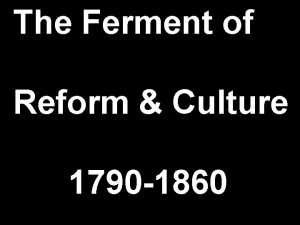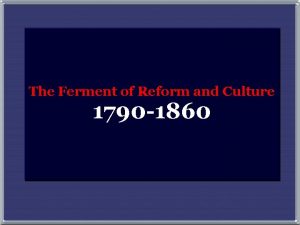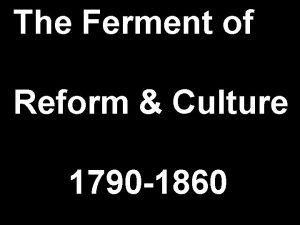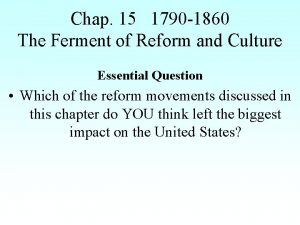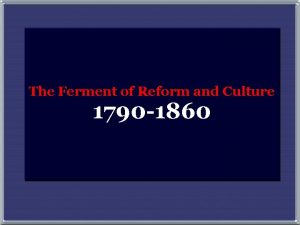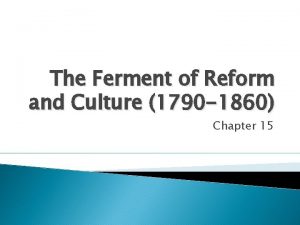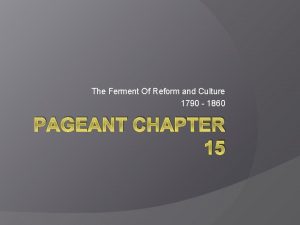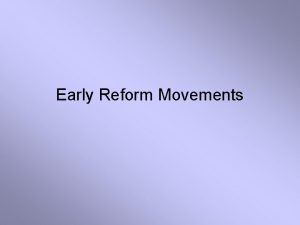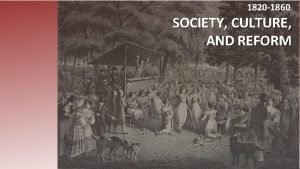The Ferment of Reform 1820 1860 Second Great



















- Slides: 19

The Ferment of Reform 1820 -1860

Second Great Awakening Ø Caused new divisions with the older Protestant churches Ø Original sin replaced with optimistic belief that willingness to be saved could ensure salvation Ø Conversion and repentance now part of the community experience Ø Reached people who needed help adjusting to social changes

Evangelism • The religion of the middle class • Stressed self-discipline and individual achievement • Women take a more active role

Charles G. Finney -New York • Appealed to people’s emotions and fear of damnation • Persuaded thousands to publicly declare their revived faith • Prayer meetings were held in schools and businesses

Joseph Smith, 1830 • Founder of the Mormon religion • Published The Book of Mormon – traced a connection between the Native Americans and the lost tribes of Israel • Church of 18, 000 members, practiced polygamy • Led followers from New York to Illinois

Brigham Young • After mob murdered Joseph Smith – Mormons fled under the leadership of Brigham Young • Established New Zion on the banks of the Great Salt Lake ghostdepot. com/rg/images/ utah/brigham

Emerson and Transcendentalism • Transcendentalism was reaction to Enlightenment – see God as a creative force within man which fostered an optimistic belief in the goodness of man • Led by Ralph Waldo Emerson, a philosopher who emphasized individualism and rejected traditional authority " All creation is one, people should try to live a simple life in harmony with nature and with others. "

Henry David Thoreau • Henry David Thoreau’s Walden describes a 2 -year experiment in self-reliance while living near Walden Pond • Outspoken advocate of abolition – conductor for the underground railroad • Jailed for refusal to pay poll tax and wrote “Civil Disobedience” leading work on passive resistance

Nathaniel Hawthorne • The Scarlet Letter, most famous work explores good and evil in a Puritan town • Explored the dark side of life

Social Utopianism • Withdrawing from conventional society to create an ideal community or “utopia” • Open lands in the U. S. was fertile ground for such communities – Shakers – Oneida Community – Brook Farm – New Harmony

William Lloyd Garrison • Founder and publisher of “The Liberator” - 1831 • Demanded immediate and complete emancipation of slaves • Founder of New England Antislavery Society and American Antislavery Society

Grimke Sisters • Members of American Anti-slavery Society • Wrote a series of antislavery books and pamphlets • Advocated women’s rights Angelina first woman to speak before the Massachusetts Legislature

Temperance Movement American Temperance Society – Felt that excessive drinking was a threat to public morality and the family

Public Asylums • Dorothea Dix – Horrified at the treatment of the mentally ill called for reforms – States began rebuilding mental hospitals and patients began receiving professional treatment at state expense http: //www. ccg-gcc. gc. ca/usque-ad-mare/photos/261197 -56. jpg

Education Horace Mann § Leading advocate of the common (public) school movement § Reformers believed schools were important for immigrants and poor children § Moral education § Advocated compulsory attendance, longer school year, and training for teachers • Special schools founded for people with disabilities

American Family • Family and the role of the mother increasingly more important • “Cult of Domesticity” • Lower birthrates and smaller families • Children received more affection

Elizabeth Stanton – Led the campaign for equal voting, legal and property rights for women – Also involved in the Abolition and Temperance Movements

Lucretia Mott • Campaigned for women’s rights after being barred from speaking at an antislavery convention • With Stanton, she started the women’s right movement

Women’s Right Convention Seneca Falls, NY July 19 -20, 1848 • Discuss the social, civil, and religious rights of women • Declaration of Sentiments – 12 resolutions for action
 Second great awakening
Second great awakening Chapter 15 the ferment of reform and culture
Chapter 15 the ferment of reform and culture The ferment of reform and culture
The ferment of reform and culture The ferment of reform and culture
The ferment of reform and culture Chapter 15 the ferment of reform and culture
Chapter 15 the ferment of reform and culture Arthur and lewis tappan apush
Arthur and lewis tappan apush Chapter 12 religion romanticism and reform
Chapter 12 religion romanticism and reform Anaerobic respiration
Anaerobic respiration Decreto 1860 de 1994
Decreto 1860 de 1994 American romanticism 1800 to 1860 worksheet answers
American romanticism 1800 to 1860 worksheet answers The romantic period in american literature
The romantic period in american literature South carolina 1860
South carolina 1860 American romanticism 1800 to 1860 worksheet answers
American romanticism 1800 to 1860 worksheet answers Map of 1860
Map of 1860 Election of 1860 definition
Election of 1860 definition 1860
1860 Border states in 1860
Border states in 1860 John breckinridge opinion on slavery
John breckinridge opinion on slavery Whig party beliefs
Whig party beliefs American romanticism 1800 to 1860 worksheet answers
American romanticism 1800 to 1860 worksheet answers
